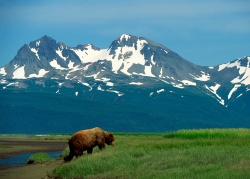Rachel Cohen is serving an internship at Climate Watch. She has written for the Oakland Tribune and San Mateo County Times.
 By Rachel Cohen
By Rachel Cohen
The federal Deptartment of the Interior has selected the University of Alaska to host the first in a network of eight “regional climate centers” around the country.
In making the selection, Interior secretary Ken Salazar called Alaska “ground zero for climate change,” citing “rapidly melting Arctic-sea ice and permafrost, and threats to the survival of Native Alaskan coastal communities.” The center will be located in Anchorage.
Salazar said that in the weeks to come, DOI will be screening proposals for the next four centers, targeted for the Northwest, Southeast, Southwest and North Central regions.
The first center follows quickly the announcement in February that NOAA is establishing a National Climate Service. Modeled on its century-old National Weather Service, the NCS will also have a regional emphasis.
“The new service will give more structure and visibility to NOAA, changing the way money moves around, and resources can be brought to bear,” said Kelly Redmond, a climatologist with NOAA’s Western Regional Climate Center in Reno.
Redmond, who has been involved with the creation of the Climate Service for the past couple years, said the new service aims to provide decision makers, including state and local planners and policymakers, with the kinds of information they’ve been asking for.
That ranges from answers to “backyard questions,” such as looking up the climate of a new home’s location or whether to fodder for major business investment decisions.
Officials say the new federal service will work within the existing budget and appoint a director to each of six regions. The Western Regional Climate Center, in Reno, where Redmond is based, is affiliated with the University of Nevada’s Desert Research Institute.
Roughly half of the total land area in the western US is federally managed. Much of it is arid and mountainous, with its own set of climate issues. NOAA works with a matrix of state and federal agencies, some with overlapping jurisdictions. The Climate Service will pull research from diverse sources under one umbrella.
Redmond says coordination of climate information is evolving along a path similar to that which led to the creation of NOAA in the 1970s. While national and local weather systems are well connected, climate programs remain fragmented. By creating a single conduit for climate information, Redmond says NOAA may be better able to prioritize research efforts.
Likewise, Salazar says his department’s Regional Climate Science Centers “will provide science about climate change impacts, help land managers adapt to the impacts, and engage the public through education initiatives.”
“In short,” said Salazar in his statement, “Climate Science Centers will better connect our scientists with land managers and the public.”
